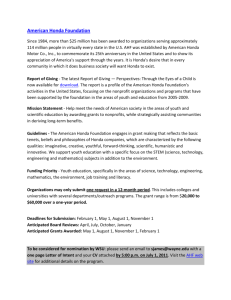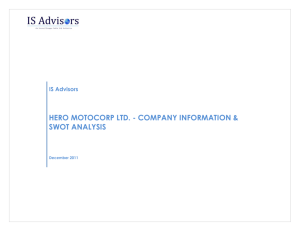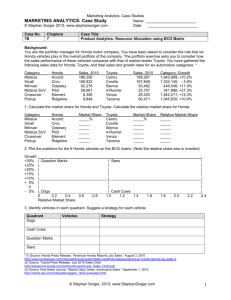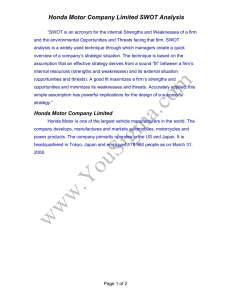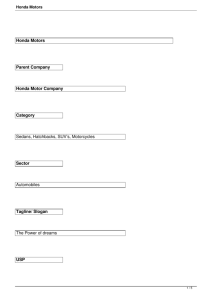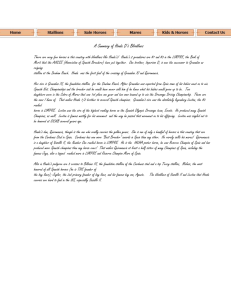1 As far as both internal and external environment of Honda Motor
advertisement
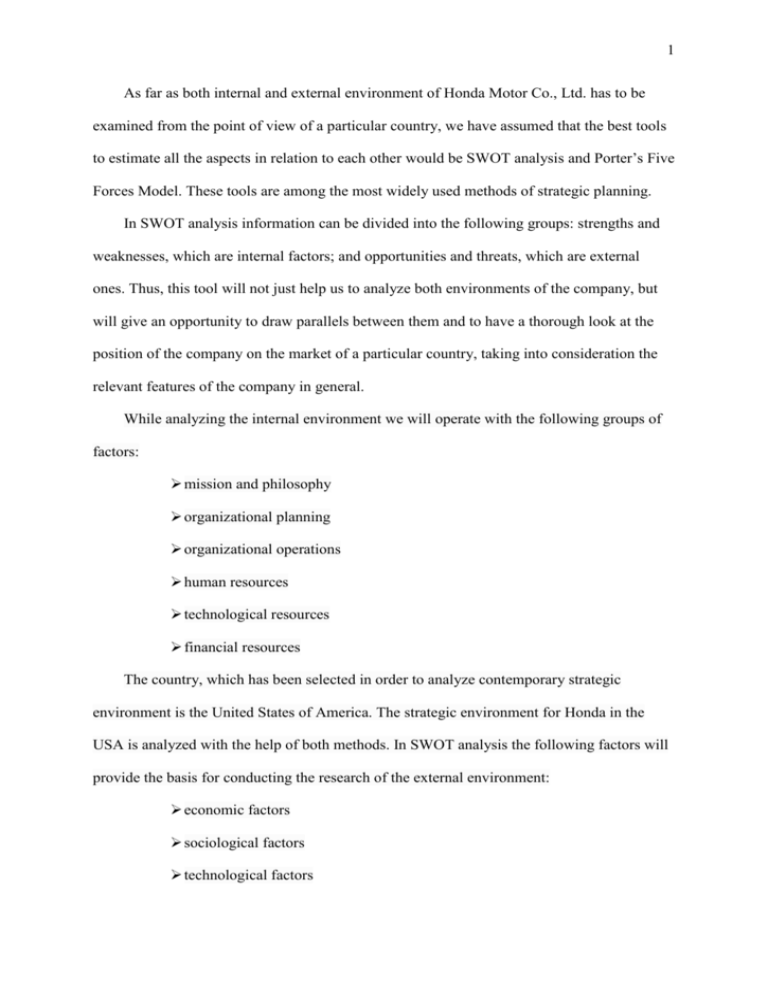
1 As far as both internal and external environment of Honda Motor Co., Ltd. has to be examined from the point of view of a particular country, we have assumed that the best tools to estimate all the aspects in relation to each other would be SWOT analysis and Porter’s Five Forces Model. These tools are among the most widely used methods of strategic planning. In SWOT analysis information can be divided into the following groups: strengths and weaknesses, which are internal factors; and opportunities and threats, which are external ones. Thus, this tool will not just help us to analyze both environments of the company, but will give an opportunity to draw parallels between them and to have a thorough look at the position of the company on the market of a particular country, taking into consideration the relevant features of the company in general. While analyzing the internal environment we will operate with the following groups of factors: mission and philosophy organizational planning organizational operations human resources technological resources financial resources The country, which has been selected in order to analyze contemporary strategic environment is the United States of America. The strategic environment for Honda in the USA is analyzed with the help of both methods. In SWOT analysis the following factors will provide the basis for conducting the research of the external environment: economic factors sociological factors technological factors 2 political/professional factors Strengths Weaknesses Honda has got highly motivational mission The prices for non-luxury automobiles statement. The organizational purpose of produced by Honda are higher than those of the company is to create top-quality the main competitors. innovative products that enhance mobility and benefit society. The company state that There is no truck-line, which could have their purposes are harmonious work and widened the opportunities of the company on high safety of their products. the world’s market. The products of the company are known to Return On Invested Capital and Return on be reliable. equity, which decreased for 60% over the past five years, shows that management and There are sales networks, research and business conditions are not that healthy. development centers and manufacturing facilities in each region, which is necessary In the period from 2007 to 2011 the net sales to answer the requirements of all the decreased from 11.087.140 to 8.936.867 customers. million yen; the net income decreased from 592.322 million yen to 534.088 million yen. Strong internal control system, which include Systems for ensuring that the The earthquake and tsunami in Japan forced execution of duties by directors and Honda to cut its production. The flooding in employees complies with the law and the to Thailand, inundated one of Honda’s plants. 3 Company's Articles of Incorporation, The Civic, Honda’s best-selling car globally, Systems related to retention and reported December sales in the US that were management of information on, Provision more than a quarter lower than a year earlier. of employees when assistance is requested Car and Driver magazine described the new by corporate auditors and independence of model in a review last spring as “an such employees from directors, etc. unadventurous effort” that had not improved on its predecessor. The establishement the Global Honda Quality Standard (G-HQS) in April 2005, according to which Honda facilities all over the world have been or are to be certified, in order to prevent any failures in quality level of products. At the present moment, Honda is the biggest manufacturer of motorcycles, and one of the biggest manufacturers of automobiles in the world. Opportunities Threats The best opportunity for Honda is If the strengthening of yen continues, the emerging markets. company can suffer great losses. Honda can increase its productivity if it Products, prices and managerial policy of its continues the policy of fuel efficiency. competitors are able to become the biggest challenge for Honda on the world’s market in 4 general, and on the US one in particular. Five Forces Model developed by Michael Porter, a Harvard University Professor, reveals the whole impact, which different aspects can have on competitiveness of a company. The core of the model is direct competitors of a company. However, the main point of the model is that besides them, there are a broader set of competitors, such as bargaining power of buyers, bargaining power of suppliers, treat of new entrants, and treat of substitute products or services. After collecting information about the market an analyst can determine components of each of the competitive sectors mentioned above. The bargaining power of buyers is slowly growing, but it does not contribute much to Honda’s positions, according to, again, high prices. Nevertheless, the situation may alter, because more and more people prefer fuel-efficient cars, so the price-difference may be pushed into the background. Bargaining Power of suppliers is rather high. Honda has a wide group of suppliers, which turns out to be an affiliated group, in which 20% of Honda’s equity stakes are held. There is almost no threat of new entrants to the market in the USA, taking into consideration its present state. However, the threat of substitute products is enormous. Moreover, as it has been mentioned, Honda’s prices are often higher. So we can conclude that competitive rivalry on the US market is high. Nowadays, many industry analysts declare that Honda has great difficulties relating to its cars’ competitiveness. The result is rather astonishing: the drop of Honda’s sales in the USA by 7 per cent is the biggest one for any carmaker in 2011. 5 References Honda Philosophy: Honda's basic principles and policies, viewed 29 February, 2012, <http://world.honda.com/profile/philosophy/> Outlook And Price Targets On Automotive Stocks (Part 2), viewed 29 February, 2012,<http://seekingalpha.com/article/386241-outlook-and-price-targets-on-automotivestocks-part-2> Reed J & Simon B, 2012, Honda faces challenges in US market, The Financial Times Limited, viewed 29 February, 2012, <http://www.ft.com/intl/cms/s/0/d9b7c030-37bd-11e1a5e0-00144feabdc0.html#axzz1nvTFlJi5>
